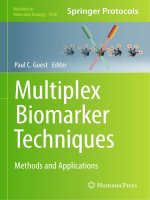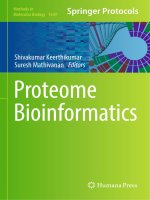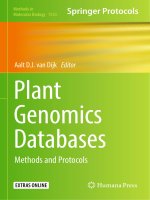Methods in molecular biology vol 1546 multiplex biomarker techniques methods and applications
Bạn đang xem bản rút gọn của tài liệu. Xem và tải ngay bản đầy đủ của tài liệu tại đây (8.7 MB, 315 trang )
Methods in
Molecular Biology 1546
Paul C. Guest Editor
Multiplex
Biomarker
Techniques
Methods and Applications
METHODS
IN
MOLECULAR BIOLOGY
Series Editor
John M. Walker
School of Life and Medical Sciences
University of Hertfordshire
Hatfield, Hertfordshire, AL10 9AB, UK
For further volumes:
/>
Multiplex Biomarker Techniques
Methods and Applications
Edited by
Paul C. Guest
Laboratory of Neuroproteomics, University of Campinas (UNICAMP), Campinas, Brazil
Editor
Paul C. Guest
Laboratory of Neuroproteomics
University of Campinas (UNICAMP)
Campinas, Brazil
ISSN 1064-3745
ISSN 1940-6029 (electronic)
Methods in Molecular Biology
ISBN 978-1-4939-6729-2
ISBN 978-1-4939-6730-8 (eBook)
DOI 10.1007/978-1-4939-6730-8
Library of Congress Control Number: 2016958277
© Springer Science+Business Media LLC 2017
This work is subject to copyright. All rights are reserved by the Publisher, whether the whole or part of the material is
concerned, specifically the rights of translation, reprinting, reuse of illustrations, recitation, broadcasting, reproduction
on microfilms or in any other physical way, and transmission or information storage and retrieval, electronic adaptation,
computer software, or by similar or dissimilar methodology now known or hereafter developed.
The use of general descriptive names, registered names, trademarks, service marks, etc. in this publication does not
imply, even in the absence of a specific statement, that such names are exempt from the relevant protective laws and
regulations and therefore free for general use.
The publisher, the authors and the editors are safe to assume that the advice and information in this book are believed to
be true and accurate at the date of publication. Neither the publisher nor the authors or the editors give a warranty,
express or implied, with respect to the material contained herein or for any errors or omissions that may have been made.
Printed on acid-free paper
This Humana Press imprint is published by Springer Nature
The registered company is Springer Science+Business Media LLC
The registered company address is: 233 Spring Street, New York, NY 10013, U.S.A.
Preface
Due to continuous technical developments and new insights into the high complexity of
many diseases, there is an increasing need for multiplex biomarker readouts for improved
clinical management and to support the development of new drugs by pharmaceutical companies. The initial rollout of these techniques has led to promising results by helping to read
patients as deeply as possible and provide clinicians with information relevant for a personalized medicine approach. This book describes the basic technology platforms being applied
in the fields of genomics, proteomics, transcriptomics, metabolomics, and imaging, which
are currently the methods of choice in multiplex biomarker research. It also describes the
chief medical areas in which the greatest progress has been made and highlights areas where
further resources are required.
More than 1000 biomarker candidates for various diseases have been described in the
scientific literature over the last 20 years. However, the rate of introduction of new biomarker tests into the clinical arena is much lower with less than 100 such tests actually
receiving approval and appearing on the marketplace. This disconnect is most likely due to
inconsistencies at the discovery end, such as technical variations within and between platforms, a lack of validation of biomarker candidates, as well as a lack of awareness within the
research community of the criteria and regulatory matters for integrating biomarkers into
the pipeline [1]. Another reason relates to the fact that many diseases are heterogeneous in
nature and comprised of different subtypes. This can cause difficulties in studies attempting
to identify biomarkers since different investigators may analyze cohorts comprised of unique
or even mixed subtypes of a particular disease, and this can make comparisons both within
and across studies invalid. Furthermore, the use of patient and control groups in clinical
studies which have not been properly stratified according to biomarker profiling is one of
the biggest causes of failure in the development of new drugs [2–9].
One way of addressing these issues is through the increasing use of multiplex biomarker
tests which can provide a more complete picture of a disease. Multiplex biomarker assays
can simultaneously measure multiple analytes in one run on a single instrument as opposed
to methods that measure only one analyte at a time or multiple analytes at different times.
The simultaneous measurement of different biomarkers in a multiplex format allows for
lower sample and reagent requirements along with reduced processing times on a per assay
basis (Table 1). In contrast, testing for single analytes can be laborious, time-consuming,
and expensive in cases where multiple assays for different molecules are required.
So how does multiplexing improve classification of diseases?
Multiplexing allows for higher sample throughput with greater cross-comparability
within and across experiments since each of the component assays are processed, read, and
analyzed under identical conditions and at the same time. This obviates traditional problems of comparing the results of single assays within a given study, which may be subject to
procedural inconsistencies in sampling, methodology, or data analysis. Most importantly,
the use of multiple biomarkers allows for greater accuracy in the diagnosis of complex diseases by providing more complete information about the perturbed physiological pathways
in a shorter time period. This includes in-depth attempts to decipher pathological changes
v
vi
Preface
Table 1
Characteristics of single versus multiplex immunoassays
Single assays
Multiplex
assays
Advantages
Disadvantages
Greater sensitivity because there is no
competition of different analytes for
reagents
Useful as a validation test after identification
of biomarker candidates
Requires prior knowledge to target
specific analytes
Requires greater amounts of sample
per analyte
Requires greater amounts of reagents
per analyte
Greater amount of time required for
analysis of multiple analytes (in
proportion to analyte number)
Low cross-comparability of multiple assays
as each one is run under different
conditions and at a different time
No prior knowledge required as it can be
Requires more complex and stringent
used for screening
statistical analyses
Greater cross-comparability across analytes Often requires bioinformatic analyses to
as all are run simultaneously under the
identify over-represented pathways
same conditions
Requires validation of analytes identified
More understanding of physiological
as significant during screens using an
pathways affected in disease due to higher
alternate technology
number of simultaneous analyte
measurements
Lower amounts of sample required
per analyte
Lower amounts of reagents required
per analyte
Lower time required for analysis of multiple
analytes
at the level of the DNA sequence [10], epigenome [11], transcriptome [12], proteome [2],
and metabolome [13]. Thus, we are now moving away from single biomarker tests to more
comprehensive multiplex biomarker analyses in order to better classify and combat these
disorders. This works in the same way that a complete fingerprint allows for more accurate
identification of a suspect in a criminal investigation as opposed to a partial print which may
not be resolvable across multiple suspects.
However, there are still challenges ahead. While some diseases are increasingly being
treated according to biomarker profiling patterns, the “one-size-fits-all” approach is still the
standard treatment for most diseases. Many diseases such as cancers [14–16], heart disease
[17], diabetes and neurological disorders [18–20] present difficult problems when it comes
to deciding on treatment options since multiple molecular pathways of complex network
signaling cascades can be affected. In addition, as these disorders can affect all age groups
and both sexes, even more variables can occur, leading to even greater variability. In order to
deal with this issue, collaborative research networks should be established for multiplexing
efforts to better integrate biomarker discovery in real time to targeted therapeutics.
Preface
vii
In the United States, the Clinical Laboratory Improved Amendments (CLIA) act was
passed by Congress in 1988 as a means of integrating quality testing for all laboratories and
to ensure accuracy, reproducibility, and speed of patient testing results [21]. The Food and
Drug Administration (FDA) is the responsible agency for applying these regulations for the
purpose of categorizing biomarker assays based on technological complexity and ease of operation. Laboratory-developed tests have not necessarily received automatic approval and have
traditionally been endorsed only at the FDA’s discretion. This is because the clinical validation
of multiplex biomarker tests will require the participation of multiple laboratories, and the
resulting platforms are likely to need simplification stages and demonstration of increased
robustness to merit extensive clinical applications. Multiplex tests may also require the use of
an algorithm to derive a composite “score” representing the multiple values of each component assay for a classification or diagnosis. For example, scores of 100 and 0 would mean a
100 % and 0 % chance respectively that the disease is present. Of course, scores in the middle
range would be less precise. Besides the multiplexing of analytes, another level of multiplexing
can be achieved by running both patient and control samples in the same assay. For example,
both cDNA arrays and two-dimensional gel electrophoresis (2D-DIGE) enable the analysis
of hundreds of analytes simultaneously for up to three samples at the same time through the
prelabeling of sample extracts with different spectrally resolvable fluorescent dyes.
The multiplex platforms for carrying out screening typically have medium to large footprints and require considerable expertise to operate. For transcriptomic or RNA-based profiling, these include quantitative PCR, cDNA microarray, and microRNA approaches. For
proteomics, there are two-dimensional difference gel electrophoresis, multiplex immunoassay, label-free shot-gun mass spectrometry, selective reaction mass spectrometry, and
labeled-based mass spectrometry platforms. For metabolomic screening, the main platforms in use are either mass spectrometry or proton nuclear magnetic resonance-based. For
clinical applications and rollout of biomarker assays, it is becoming increasingly important
that the platforms are small, user friendly, and fast so they can be used in a point-of-care
setting. The latest developments along these lines include lab-on-a-chip and mobile phone
applications. Detailed protocols describing both the discovery and point-of-care devices
incorporating multiplexed assays are described in this book.
Campinas, Brazil
Paul C. Guest
References
1. Boja ES, Jortani SA, Ritchie J, Hoofnagle AN, Težak Ž, Mansfield E et al (2011) The journey to regulation of protein-based multiplex quantitative assays. Clin Chem 57:560–567.
2. Lee JM, Kohn EC (2010) Proteomics as a guiding tool for more effective personalized therapy. Ann
Oncol 21(Suppl 7):vii205–vii10. doi: 10.1093/annonc/mdq375. Review
3. Lee JM, Han JJ, Altwerger G, Kohn EC (2011) Proteomics and biomarkers in clinical trials for drug development. J Proteomics 74:2632–2641.
4. Kelloff GJ, Sigman CC (2012) Cancer biomarkers: selecting the right drug for the right patient. Nat
Rev Drug Discov 11:201–214.
5. Begg CB, Zabor EC, Bernstein JL, Bernstein L, Press MF, Seshan VE (2013) A conceptual and methodological framework for investigating etiologic heterogeneity. Stat Med 32:5039–5052.
6. Henriksen K, O’Bryant SE, Hampel H, Trojanowski JQ, Montine TJ, Jeromin A et al (2014) Bloodbased biomarker interest group. Alzheimers Dement 10:115–131.
7. Guest PC, Chan MK, Gottschalk MG, Bahn S (2014) The use of proteomic biomarkers for improved
diagnosis and stratification of schizophrenia patients. Biomark Med 8:15–27.
viii
Preface
8. Wang X, Adjei AA (2015) Lung cancer and metastasis: new opportunities and challenges. Cancer
Metastasis Rev 34:169–171.
9. Hudler P (2015) Challenges of deciphering gastric cancer heterogeneity. World J Gastroenterol
21:10510–10527.
10. Hudson TJ (2013) Genome variation and personalized cancer medicine. J Intern Med
274:440–450.
11. Mummaneni P, Shord SS (2014) Epigenetics and oncology. Pharmacotherapy 34:495–505.
12. Hu YF, Kaplow J, He Y (2005) From traditional biomarkers to transcriptome analysis in drug development. Curr Mol Med 5:29–38.
13. Wishart DS (2008) Applications of metabolomics in drug discovery and development. Drugs R D
9:307–322.
14. Füzéry AK, Levin J, Chan MM, Chan DW (2013) Translation of proteomic biomarkers into FDA
approved cancer diagnostics: issues and challenges. Clin Proteomics 10:13. doi:
10.1186/1559-0275-10-13.
15. Nolen BM, Lokshin AE (2013) Biomarker testing for ovarian cancer: clinical utility of multiplex assays.
Mol Diagn Ther 17:139–146.
16. Ploussard G, de la Taille A (2010) Urine biomarkers in prostate cancer. Nat Rev Urol 7:101–109.
17. Vistnes M, Christensen G, Omland T (2010) Multiple cytokine biomarkers in heart failure. Expert
Rev Mol Diagn 10:147–157.
18. Lee KS, Chung JH, Choi TK, Suh SY, Oh BH, Hong CH (2009) Peripheral cytokines and chemokines in Alzheimer’s disease. Dement Geriatr Cogn Disord 28:281–287.
19. Kang JH, Vanderstichele H, Trojanowski JQ, Shaw LM (2012) Simultaneous analysis of cerebrospinal fluid
biomarkers using microsphere-based xMAP multiplex technology for early detection of Alzheimer’s disease.
Methods 56:484–493.
20. Chan MK, Krebs MO, Cox D, Guest PC, Yolken RH, Rahmoune H et al (2015) Development of a
blood-based molecular biomarker test for identification of schizophrenia before disease onset. Transl
Psychiatry 5:e601. doi: 10.1038/tp.2015.91.
21. />
Contents
Preface. . . . . . . . . . . . . . . . . . . . . . . . . . . . . . . . . . . . . . . . . . . . . . . . . . . . . . . . . .
Contributors . . . . . . . . . . . . . . . . . . . . . . . . . . . . . . . . . . . . . . . . . . . . . . . . . . . . . . . . . .
PART I
REVIEWS
1 Application of Multiplex Biomarker Approaches to Accelerate
Drug Discovery and Development . . . . . . . . . . . . . . . . . . . . . . . . . . . . . . . . .
Hassan Rahmoune and Paul C. Guest
2 The Application of Multiplex Biomarker Techniques
for Improved Stratification and Treatment of Schizophrenia Patients . . . . . . . .
Johann Steiner, Paul C. Guest, Hassan Rahmoune,
and Daniel Martins-de-Souza
3 Multiplex Biomarker Approaches in Type 2 Diabetes Mellitus Research. . . . . .
Susan E. Ozanne, Hassan Rahmoune, and Paul C. Guest
4 LC-MSE, Multiplex MS/MS, Ion Mobility, and Label-Free Quantitation
in Clinical Proteomics . . . . . . . . . . . . . . . . . . . . . . . . . . . . . . . . . . . . . . . . . . .
Gustavo Henrique Martins Ferreira Souza, Paul C. Guest,
and Daniel Martins-de-Souza
5 Phenotyping Multiple Subsets of Immune Cells In Situ
in FFPE Tissue Sections: An Overview of Methodologies . . . . . . . . . . . . . . . .
James R. Mansfield
PART II
3
19
37
57
75
STATISTICAL CONSIDERATIONS
6 Identification and Clinical Translation of Biomarker Signatures:
Statistical Considerations. . . . . . . . . . . . . . . . . . . . . . . . . . . . . . . . . . . . . . . . .
Emanuel Schwarz
7 Opportunities and Challenges of Multiplex Assays:
A Machine Learning Perspective . . . . . . . . . . . . . . . . . . . . . . . . . . . . . . . . . . .
Junfang Chen and Emanuel Schwarz
PART III
v
xiii
103
115
PROTOCOLS
8 Multiplex Analyses Using Real-Time Quantitative PCR . . . . . . . . . . . . . . . . . .
Steve F.C. Hawkins and Paul C. Guest
9 Multiplex Analysis Using cDNA Transcriptomic Profiling . . . . . . . . . . . . . . . .
Steve F.C. Hawkins and Paul C. Guest
10 Multiplex Single Nucleotide Polymorphism Analyses . . . . . . . . . . . . . . . . . . . .
Steve F.C. Hawkins and Paul C. Guest
ix
125
135
143
x
Contents
11 Pulsed SILAC as a Approach for miRNA Targets Identification
in Cell Culture . . . . . . . . . . . . . . . . . . . . . . . . . . . . . . . . . . . . . . . . . . . . . . . .
Daniella E. Duque-Guimarães, Juliana de Almeida-Faria,
Thomas Prates Ong, and Susan E. Ozanne
12 Blood Bio-Sampling Procedures for Multiplex Biomarkers Studies. . . . . . . . . .
Paul C. Guest and Hassan Rahmoune
13 Multiplex Immunoassay Profiling . . . . . . . . . . . . . . . . . . . . . . . . . . . . . . . . . .
Laurie Stephen
14 Multiplex Sequential Immunoprecipitation of Insulin Secretory
Granule Proteins from Radiolabeled Pancreatic Islets. . . . . . . . . . . . . . . . . . . .
Paul C. Guest
15 Two Dimensional Gel Electrophoresis of Insulin Secretory Granule Proteins
from Biosynthetically-Labeled Pancreatic Islets . . . . . . . . . . . . . . . . . . . . . . . .
Paul C. Guest
16 Depletion of Highly Abundant Proteins of the Human Blood Plasma:
Applications in Proteomics Studies of Psychiatric Disorders . . . . . . . . . . . . . . .
Sheila Garcia, Paulo A. Baldasso, Paul C. Guest,
and Daniel Martins-de-Souza
17 Simultaneous Two-Dimensional Difference Gel Electrophoresis (2D-DIGE)
Analysis of Two Distinct Proteomes . . . . . . . . . . . . . . . . . . . . . . . . . . . . . . . .
Adriano Aquino, Paul C. Guest, and Daniel Martins-de-Souza
18 Selective Reaction Monitoring for Quantitation of Cellular Proteins . . . . . . . .
Vitor M. Faça
19 Characterization of a Protein Interactome by Co-Immunoprecipitation
and Shotgun Mass Spectrometry . . . . . . . . . . . . . . . . . . . . . . . . . . . . . . . . . . .
Giuseppina Maccarrone, Juan Jose Bonfiglio, Susana Silberstein,
Christoph W. Turck, and Daniel Martins-de-Souza
20 Using 15N-Metabolic Labeling for Quantitative Proteomic Analyses. . . . . . . . .
Giuseppina Maccarrone, Alon Chen, and Michaela D. Filiou
21 Multiplex Measurement of Serum Folate Vitamers by UPLC-MS/MS. . . . . . .
Sarah Meadows
22 UPLC-MS/MS Determination of Deuterated 25-Hydroxyvitamin D
(d3-25OHD3) and Other Vitamin D Metabolites for the Measurement
of 25OHD Half-Life. . . . . . . . . . . . . . . . . . . . . . . . . . . . . . . . . . . . . . . . . . . .
Shima Assar, Inez Schoenmakers, Albert Koulman, Ann Prentice,
and Kerry S. Jones
23 iTRAQ-Based Shotgun Proteomics Approach for Relative
Protein Quantification . . . . . . . . . . . . . . . . . . . . . . . . . . . . . . . . . . . . . . . . . .
Erika Velásquez Núñez, Gilberto Barbosa Domont, and Fábio César Sousa
Nogueira
1
24 H NMR Metabolomic Profiling of Human and Animal Blood
Serum Samples . . . . . . . . . . . . . . . . . . . . . . . . . . . . . . . . . . . . . . . . . . . . . . . .
João G.M. Pontes, Antonio J.M. Brasil, Guilherme C.F. Cruz,
Rafael N. de Souza, and Ljubica Tasic
149
161
169
177
187
195
205
213
223
235
245
257
267
275
Contents
25 Lab-on-a-Chip Multiplex Assays . . . . . . . . . . . . . . . . . . . . . . . . . . . . . . . . . . .
Harald Peter, Julia Wienke, and Frank F. Bier
26 Multiplex Smartphone Diagnostics . . . . . . . . . . . . . . . . . . . . . . . . . . . . . . . . .
Juan L. Martinez-Hurtado, Ali K. Yetisen, and Seok-Hyun Yun
27 Development of a User-Friendly App for Assisting
Anticoagulation Treatment . . . . . . . . . . . . . . . . . . . . . . . . . . . . . . . . . . . . . . .
Johannes Vegt
PART IV
xi
283
295
303
FUTURE DIRECTIONS
28 Multiplex Biomarker Approaches to Enable Point-of-Care Testing
and Personalized Medicine . . . . . . . . . . . . . . . . . . . . . . . . . . . . . . . . . . . . . . .
Paul C. Guest
311
Index . . . . . . . . . . . . . . . . . . . . . . . . . . . . . . . . . . . . . . . . . . . . . . . . . . . . . . . . . . . . . . .
317
Contributors
JULIANA DE ALMEIDA-FARIA • University of Cambridge Metabolic Research Laboratories
and MRC Metabolic Diseases Unit, Wellcome Trust-MRC Institute of Metabolic Science,
Addenbrooke’s Hospital, Cambridge, UK; Faculty of Medical Sciences, Department of
Pharmacology, State University of Campinas, Campinas, Brazil
ADRIANO AQUINO • Laboratory of Neuroproteomics, Department of Biochemistry and Tissue
Biology, Institute of Biology, University of Campinas (UNICAMP), Campinas, SP,
Brazil
SHIMA ASSAR • MRC Elsie Widdowson Laboratory, Cambridge, UK
PAULO A. BALDASSO • Laboratory of Neuroproteomics, Department of Biochemistry and
Tissue Biology, Institute of Biology, University of Campinas (UNICAMP), Campinas, SP,
Brazil
FRANK F. BIER • Fraunhofer Institute for Cell Therapy and Immunology, Branch
Bioanalytics and Bioprocesses (IZI-BB), Potsdam, Germany
JUAN JOSE BONFIGLIO • Instituto de Investigación en Biomedicina de Buenos Aires
(IBioBA), CONICET, Partner Institute of the Max Planck Society, Buenos Aires,
Argentina
ANTONIO J.M. BRASIL • Chemical Biology Laboratory, Institute of Chemistry, Organic
Chemistry Department, State University of Campinas, Campinas, SP, Brazil
ALON CHEN • Department Stress Neurobiology and Neurogenetics, Max Planck Institute of
Psychiatry, Munich, Germany
JUNFANG CHEN • Department of Psychiatry and Psychotherapy, Central Institute of Mental
Health, Medical Faculty Mannheim, Heidelberg University, Mannheim, Germany
GUILHERME C.F. CRUZ • Chemical Biology Laboratory, Institute of Chemistry, Organic
Chemistry Department, State University of Campinas, Campinas, SP, Brazil
GILBERTO BARBOSA DOMONT • Laboratory of Protein Chemistry–Proteomics Unit,
Chemistry Institute, Federal University of Rio de Janeiro, Rio de Janeiro, Brazil
DANIELLA E. DUQUE-GUIMARÃES • University of Cambridge Metabolic Research
Laboratories and MRC Metabolic Diseases Unit, Wellcome Trust-MRC Institute of
Metabolic Science, Addenbrooke’s Hospital, Cambridge, UK; Department of Physiology
and Biophysics, Institute of Biomedical Sciences, University of São Paulo, SP, Brazil
VITOR M. FAÇA • Department of Biochemistry and Immunology, Ribeirão Preto Medical
School, University of São Paulo, RibeirãoPreto, SP, Brazil; Center for Cell Based
Therapy - Hemotherapy Center of Ribeirão Preto, Ribeirão Preto Medical School,
University of São Paulo, Ribeirão Preto, SP, Brazil
MICHAELA D. FILIOU • Department Stress Neurobiology and Neurogenetics, Max Planck
Institute of Psychiatry, Munich, Germany
SHEILA GARCIA • Laboratory of Neuroproteomics, Department of Biochemistry and Tissue
Biology, Institute of Biology, University of Campinas (UNICAMP), Campinas, SP,
Brazil
PAUL C. GUEST • Laboratory of Neuroproteomics, Department of Biochemistry and Tissue
Biology, Institute of Biology, University of Campinas (UNICAMP), Campinas, SP,
Brazil
xiii
xiv
Contributors
STEVE F.C. HAWKINS • Bioline Reagents Limited, Unit 16, The Edge Business Centre,
London, UK
KERRY S. JONES • MRC Elsie Widdowson Laboratory, Cambridge, UK
ALBERT KOULMAN • MRC Elsie Widdowson Laboratory, Cambridge, UK
GIUSEPPINA MACCARRONE • Department of Translational Research in Psychiatry, Max
Planck Institute of Psychiatry, Munich, Germany
JAMES R. MANSFIELD • Andor Technology, Concord, MA, USA
JUAN L. MARTINEZ-HURTADO • Department of Chemical Engineering and Biotechnology,
University of Cambridge, Cambridge, UK
DANIEL MARTINS-DE-SOUZA • Department of Biochemistry and Tissue Biology, Neurobiology
Center and Laboratory of Neuroproteomics, Institute of Biology, University of Campinas
(UNICAMP), Campinas, SP, Brazil
SARAH MEADOWS • MRC Human Nutrition Research, Cambridge, UK
FÁBIO CÉSAR SOUSA NOGUEIRA • Laboratory of Protein Chemistry—Proteomics Unit,
Chemistry Institute, Federal University of Rio de Janeiro, Rio de Janeiro, Brazil
ERIKA VELÁSQUEZ NÚÑEZ • Laboratory of Protein Chemistry— Proteomics Unit, Chemistry
Institute, Federal University of Rio de Janeiro, Rio de Janeiro, Brazil
THOMAS PRATES ONG • University of Cambridge Metabolic Research Laboratories and
MRC Metabolic Diseases Unit, Wellcome Trust-MRC Institute of Metabolic Science,
Addenbrooke’s Hospital, Cambridge, UK; Food Research Center (FoRC) and Faculty of
Pharmaceutical Sciences, University of São Paulo, São Paulo, Brazil
SUSAN E. OZANNE • University of Cambridge Metabolic Research Laboratories and MRC
Metabolic Diseases Unit, Wellcome Trust-MRC Institute of Metabolic Science,
Addenbrooke’s Hospital, Cambridge, UK
HARALD PETER • Fraunhofer Institute for Cell Therapy and Immunology, Branch
Bioanalytics and Bioprocesses (IZI-BB), Potsdam, Germany
JOÃO G.M. PONTES • Chemical Biology Laboratory, Institute of Chemistry, Organic
Chemistry Department, State University of Campinas, Campinas, SP, Brazil
ANN PRENTICE • MRC Elsie Widdowson Laboratory, Cambridge, UK
HASSAN RAHMOUNE • Department of Chemical Engineering and Biotechnology, University
of Cambridge, Cambridge, UK
INEZ SCHOENMAKERS • MRC Elsie Widdowson Laboratory, Cambridge, UK
EMANUEL SCHWARZ • Department of Psychiatry and Psychotherapy, Medical Faculty
Mannheim, Central Institute of Mental Health, Heidelberg University, Mannheim,
Germany
SUSANA SILBERSTEIN • Instituto de Investigación en Biomedicina de Buenos Aires (IBioBA),
CONICET, Partner Institute of the Max Planck Society, Buenos Aires, Argentina
GUSTAVO HENRIQUE MARTINS FERREIRA SOUZA • Mass Spectrometry Applications and
Development Laboratory, Waters Corporation, São Paulo, SP, Brazil
RAFAEL N. DE SOUZA • Chemical Biology Laboratory, Institute of Chemistry, Organic
Chemistry Department, State University of Campinas, Campinas, SP, Brazil
JOHANN STEINER • Department of Psychiatry, University of Magdeburg, Magdeburg,
Germany
LAURIE STEPHEN • Ampersand Biosciences, Saranac Lake, NY, USA
LJUBICA TASIC • Chemical Biology Laboratory, Institute of Chemistry, Organic Chemistry
Department, State University of Campinas, Campinas, SP, Brazil
Contributors
xv
CHRISTOPH W. TURCK • Department of Translational Research in Psychiatry, Max Planck
Institute of Psychiatry, Munich, Germany
JOHANNES VEGT • Appamedix UG i.gr, Innovations-Centrum CHIC, Berlin, Germany
JULIA WIENKE • Fraunhofer Institute for Cell Therapy and Immunology, Branch
Bioanalytics and Bioprocesses (IZI-BB), Potsdam, Germany
ALI K. YETISEN • Harvard Medical School and Wellman Center for Photomedicine,
Massachusetts General Hospital, Cambridge, MA, USA; Harvard-MIT Division of
Health Sciences and Technology, Massachusetts Institute of Technology, Cambridge,
MA, USA
SEOK H. YUN • Harvard Medical School and Wellman Center for Photomedicine,
Massachusetts General Hospital, Cambridge, MA, USA; Harvard-MIT Division
of Health Sciences and Technology, Massachusetts Institute of Technology, Cambridge,
MA, USA
Part I
Reviews
Chapter 1
Application of Multiplex Biomarker Approaches
to Accelerate Drug Discovery and Development
Hassan Rahmoune and Paul C. Guest
Abstract
Multiplex biomarker tests are becoming an essential part of the drug development process. This chapter
explores the role of biomarker-based tests as effective tools in improving preclinical research and clinical
development, and the challenges that this presents. The potential of incorporating biomarkers in the clinical pipeline to improve decision making, accelerate drug development, improve translation, and reduce
development costs is discussed. This chapter also discusses the latest biomarker technologies in use to make
this possible and details the next steps that must undertaken to keep driving this process forwards.
Key words Pharmaceutical company, Drug discovery, Biomarker, Genomics, Transcriptomics,
Proteomics, Metabolomics
1
Introduction
Pharmaceutical companies are under pressure to improve their
returns on existing and novel drug discovery efforts. This is an
almost impossible task, considering that the average drug costs
approximately one billion US dollars to develop and takes 10–15
years from initial discovery to the marketing phase [1]. This problem is compounded by the fact that around 70 % of drugs do not
recover their research and development costs and approximately
90 % fail to yield an adequate return on investment. In addition,
fewer than one in ten new drugs entering clinical trials make it to
the market and some of those that do make it experience withdrawal and/or litigation [2–5]. Therefore, in order for the pharmaceutical companies to survive, minimizing these risks has
become one of the most important objectives in drug discovery
projects in recent years. For example, there has been considerable
effort aimed at establishing standard operating procedures to plot
a course through these problems and to help meet the intimidating
regulatory demands. But the regulatory agencies have not just
been standing by idling watching. In order to assist pharmaceutical
Paul C. Guest (ed.), Multiplex Biomarker Techniques: Methods and Applications, Methods in Molecular Biology, vol. 1546,
DOI 10.1007/978-1-4939-6730-8_1, © Springer Science+Business Media LLC 2017
3
4
Hassan Rahmoune and Paul C. Guest
companies in this process, they have encouraged the incorporation
of biomarker-based tests into the drug discovery pipeline and the
Food and Drug Administration (FDA) has initiated efforts to
modernize and standardize all involved procedures to facilitate
delivery of more effective and safer drugs [6]. The FDA has estimated even a 10 % improvement in the ability to predict failure of
drug before it enters the clinical trial phases could save as much as
one hundred million US dollars in development costs per drug [7].
2
A Brief History of Failed Drugs
The need for biomarker tests to guide drug development is perhaps best seen by recent major failures in this process. Over the last
two decades more than 30 drugs have been withdrawn, mainly as
a result of hepatotoxic or cardiotoxic effects [8]. In 1997, the FDA
recommended that the antihistamine drug Terfendine be withdrawn from the market due to an association with heart arrhythmia, which could increase the risk of heart attacks and death [9].
In the year 2000, the antidiabetic and anti-inflammatory drug
Troglitazone was withdrawn due to reports of liver toxicity [10].
In 2001, the 3-hydroxy-3-methylglutaryl-coenzyme A reductase
inhibitor Cerivastatin, developed to treat high cholesterol levels,
was withdrawn due to an increased risk of rhabdomyolysis, a severe
condition that causes muscle pain and weakness and can sometimes
result in renal failure and death [11, 12]. In 2003, the antidepressant drug Nefazodone was withdrawn due to liver toxicity [13].
One of the most infamous cases was the withdrawal of the antiinflammatory drug Vioxx by Merck, due to reports about its
increased risk of heart attack and stroke [14]. Merck agreed to pay
4.85 billion US dollars in damages three years after the withdrawal
and also had to pay a further 285 million US dollars four years later
in the face of charges that it “duped customers” into buying the
drug [15]. Another infamous case was the serious adverse effects
seen in phase I clinical studies of the monoclonal antibody
TGN1412, produced by TeGenero [16]. TGN1412 was originally
tested as a potential treatment for B cell chronic lymphocytic leukemia and rheumatoid arthritis and had shown no toxic effects in
preclinical studies. The compound was withdrawn in 2006 after six
healthy male volunteers who took part in the phase I trial experienced the beginnings of a “cytokine storm” within 90 min after
receiving it. The phrase cytokine storm describes a proinflammatory effect, resulting in fever, pain, and organ failure. All of the
volunteers required weeks of hospitalization. This and the other
cases stated above indicate that these disasters may not have
occurred if procedures been adopted using safety biomarkers to
guide dosing and/or predict toxicities at an early stage in the drug
discovery process.
Multiplex Biomarkers for Drug Discovery
3
5
Biomarker Impact in the Drug Discovery Process
Estimates are that the total number of potential biomarkers is
higher than one million, which is clearly an overwhelming number.
However, many researchers and pharmaceutical companies have
been investing in multiplex “omics” technologies to assist in sorting through this mass of analytes and help in understanding diseases at a deeper level than ever before. These platforms consist of
genomics, transcriptomics, proteomics, and metabonomics, along
with others. All of these approaches involve identification of molecular fingerprints from clinical samples and convert this into information about physiological status. With the help of these multiplex
biomarker approaches, we are just now beginning to able to better
categorize diseases at the molecular level, rather than on symptoms
alone. By finding molecular biomarkers of a disease, early detection
and diagnosis could be improved by simply testing for the presence
of the disease fingerprint. Biomarkers would also assist pharmaceutical companies who could now look for drugs which help to normalize disease-like signatures. These could be used in early
preclinical stages of drug development such as by looking at the
effect of test compounds in disease models. They could also assist
in looking for markers of toxicity prior to entry of the drug into
clinical trials if representative models could be developed. In the
later stages, biomarker tests could be used to help stratify patient
groups in order to identify those who are most likely to benefit
from treatment. This is critical as too many trials may have failed
simply due to the fact that the wrong patients were included in the
study. This alone could save millions in costs since the phase II and
phase III stages of clinical trials are normally the most expensive
steps in the drug discovery process.
4
Multiplex Biomarker Techniques
Biomarkers are physical characteristics that can be measured in biosamples and used as an indication of physiological states such as
good health, disease, or toxicity or to predict or monitor drug
response [17]. For practical purposes, it is becoming increasing
important that biomarkers can be measured with high accuracy
and reproducibility, within a short timeframe and at an affordable
cost. A biomarker should also reflect the underlying nature of the
disorder or condition under investigation, at least to some extent.
Many types of biomarker tests have emerged such as DNA sequencing for genomic studies and DNA microarrays and quantitative
polymerase chain reaction (qPCR) for transcriptomic analyses. The
sections below focus on methods that deliver proteomic and
metabolomic profiles or “fingerprints” in blood samples. Since
6
Hassan Rahmoune and Paul C. Guest
changes in physiological states are dynamic in nature, these are
likely to introduce alterations in numerous proteins and metabolites that converge on similar pathways. Most researchers now consider proteomics and metabolomic methods to be among the most
informative regarding physiological status, considering that proteins and metabolites actually carry out, respond to, or are reflective of most processes of the body. Furthermore, most of the drugs
in use today are designed to turn on or turn off proteins such as
receptors or enzymes, or induce metabolic changes which can be
seen as turnover of various proteins and small molecules.
4.1 Multiplex
Immunoassay
Analysis of Proteins
and Metabolites
Blood serum and plasma contain several vital bioactive and regulatory molecules, including hormones, growth factors, and cytokines. The problem is that most of these molecules are present only
at exceeding low concentrations and, therefore, measurement of
these requires highly sensitive detection methods. One way of
achieving this is through the use of multiplex immunoassay
approaches [18]. These assays can target both proteins and metabolites. They are constructed and carried out as follows: (1) microsphere are loaded with different ratios of red and infrared dyes to
give unique fluorescent signatures; (2) specific capture antibodies
are attached to the surface of micro-spheres with specific signatures; (3) The antibody–sphere conjugates are mixed together to
form the multiplex; (4) the sample is added and the target molecules bind to their respective antibody–sphere conjugates; (5) fluorescently labeled detection antibodies are added in a mixture and
each of these binds to their target molecules in a sandwich format;
and (6) the samples are streamed though a reader and the microspheres analyzed by two lasers for identification and quantification
of the analyte present. In this final step, the lasers identify which
analytes are present by measuring the unique signature of each
dye-loaded micro-sphere and determine the amount of analyte
bound by measuring the fluorescence associated with the fluorescent tags on the secondary antibodies (this is proportional to the
analyte concentration).
4.2 Two-Dimensional
Gel Electrophoresis
of Proteins
Two-dimensional gel electrophoresis (2DE) works as follows: (1)
protein mixtures in bio-samples are first applied to a strip gel allowing their separation according to their isoelectric points (this is pH
at which no net charge occurs on the protein) using isoelectric
focusing; (2) next the proteins are separated according to their
apparent molecular weights by application of the strip to the top of
a sodium dodecyl sulfate–polyacrylamide gel and second electrophoresis step; and (3) the protein spots in the gels can be visualized
with any number of stains (e.g., Coomassie Blue or Sypro Ruby)
and then quantitated using an imaging software. The 2DE technique allows the study of many tissue types but there are some
problems with analysis of blood serum or plasma samples. This
Multiplex Biomarkers for Drug Discovery
7
occurs mainly due to the fact that blood contains a massive concentration range of proteins spanning at least 14 orders of magnitude
[19]. This means that very abundant proteins such as albumin and
the immunoglobulin chains would appear as large blobs on the
gels and eclipse less abundant proteins such as the cytokines.
However, a key advantage of 2DE is that it can generate information on intact proteins including any effects on posttranslational
modifications, such as phosphorylation or glycosylation changes.
This is not as simple using other proteomic methods such as shotgun mass spectrometry (below).
4.3 Mass
Spectrometry
Just about the time that the human genome project was ending, a
revolution in shotgun mass spectrometry began as this was developed as a sensitive and medium throughput approach for proteomic biomarker identification [20]. The term “shotgun” derives
from the fact that the protein in bio-samples are cleaved with proteolytic enzymes to generate smaller peptides (analogous to shotgun pellets), which are the actual analytes. This is performed as
most intact proteins are too large and complex in their structure
to be ionized or analyzed directly in a mass spectrometer. After
proteolysis, the resulting peptides are separated according to physiochemical properties, such as hydrophobicity, using liquid chromatography so that they enter the mass spectrometer more or less
one at a time. As the peptides enter the mass spectrometer, they
are ionized by a process such as electro-spray, which is basically
application of an electric charge to evaporate the fluids, leaving
the peptides in a charged plasma state. After this, the peptide ions
are accelerated by magnets in the mass spectrometer towards a
detector at a rate that is inversely proportional to their mass over
charge ratios (m/z). Quantitation can be carried out since the
amount of each peptide hitting the detector per second is directly
proportional to the quantity of the peptide and, by derivation, to
that of the corresponding parent protein. At the same time, the
sequence of the peptide can be determined by streaming in a gas
such as nitrogen, which breaks the peptides into smaller pieces.
The mass of each piece can then be used to derive the amino acid
sequences that make up the peptides and these are used to search
protein databases for identification of the parent proteins. The
main advantage of this method is the ability to detect more difficult classes of proteins which are not detectable by 2DE approaches.
The disadvantages include the loss of intact protein information
since the proteins are enzymatically digested prior to analysis. This
method is also used for metabolomic analysis although there is no
need for enzymatic cleavage of the molecules as metabolites are
normally of a manageable size and structure. In this case, the sample can be infused directly into the mass spectrometer, the quantity calculated as described above and the identity determined by
comparisons to known standards in metabolomic databases.
8
Hassan Rahmoune and Paul C. Guest
4.4 1H (Proton)Nuclear Magnetic
Resonance (NMR)
Spectroscopy
5
As with mass spectrometry, proton NMR spectroscopy can be used
for metabolomic and small molecule analyses, although in this
method no separation or pre-fractionation of the molecules is
required. Major advantages of this approach include the points
that the sample preparation step is direct and simple and that it is
highly reproducible at the analytical level. One drawback is that it
is less sensitive compared to the mass spectrometry-based metabolomic techniques [21, 22]. The 1H-NMR method can yield information about the structural properties of metabolites and is
therefore highly used for identification purposes. This works since
the method can track the behavior of protons as the nuclei of each
proton on the molecule of interest lines up in a strong magnetic
field. The procedure begins with the application of radio frequency
pulses to the sample. This induces the nuclei to change their rotation away from their equilibrium position in line with the axis of
the magnetic field and the frequency of rotation is directly related
to its physiochemical environment within the parent metabolite.
Therefore, by using different combinations of radio pulses, one
can determine how each atom interacts with the other atoms,
yielding the structure and, consequently, the metabolite identity.
Proton NMR spectroscopy can be used to monitor relative changes
in the levels of small molecules and metabolites such as amino
acids, vitamins, neurotransmitters, and neurotransmitter precursors, making it useful for biomarker studies of multiple disorders.
Use of Multiplex Biomarker Profiling in the Drug Discovery Process
Biomarker profiling can be used at multiple stages of drug discovery process as shown in Fig. 1 and described below in further
detail. In the discovery phase, multiplex biomarker profiling could
positively impact on target identification, target validation, lead
compound prioritization, and efficacy screening of suitable preclinical models. In addition, applications in the development phase
include the production of surrogate biomarkers for drug efficacy
and for the validation of preclinical models of human diseases.
Perhaps most importantly, any biomarker tests that arise from these
earlier phase can be translated into user friendly point-of-care
devices that can be used to identify disease signatures and for
monitoring drug efficacy or toxicity in the clinical trial phases. In
this way, mechanistic or targeted biomarkers can be used in preclinical or clinical development to validate the suitability of preclinical models and establish and facilitate translational medicine by
providing pharmacological and biological biomarkers to predict
clinical outcome (Fig. 2).
5.1
Target Validation
Most existing drug targets are components of a limited number of
molecular networks that have been validated at the biological and
Lead
opƟmizaƟon
Time
Development of
prototype assay
Drug toxicity
studies
Phase I
Approval and
launch
Clinical validation and development of
user friendly hand held diagnostic device
Clinical studies
Phase II
Phase III
Fig. 1 Co-development of drugs with biomarker tests over the stages of drug discovery. The scenario is expected to lead to the development of more efficacious
and safer drugs and reduce the overall process time, leading to greater returns on investment
Biomarker identification
and validation
Target
idenƟficaƟon
DRUG DISCOVERY PIPELINE
Multiplex Biomarkers for Drug Discovery
9
Reverse translaƟon
Disease
biomarkers
Safety
biomarkers
Biomarkers
and/or targets
Disease
biomarkers
Point of
care device
Efficacy
biomarkers
Metabolomics
Proteomics
Transcriptomics
Genomics
Efficacy
biomarkers
Safety
biomarkers
Biomarkers
and/or targets
Clinical studies
Fig. 2 Translation and reverse translation of safety, efficacy, and disease biomarkers to characterize preclinical models and enable clinical development based on
personalized medicine strategies
Metabolomics
Proteomics
Transcriptomics
Genomics
Pre-clinical studies
TranslaƟon
10
Hassan Rahmoune and Paul C. Guest
Multiplex Biomarkers for Drug Discovery
11
physiological levels [23]. However, many of these networks have
not been fully elucidated in terms of the interacting transcript, protein and small molecule components and their relationship to other
biological pathways. Therefore, there is a need for “mining” cell
signaling and whole body networks further in order to identify
novel tractable drug targets. Identification of molecules that operate as switch factors in the disease process is usually the first stage
of target validation. This can be tested by manipulating the expression of the target molecules using gain or loss of function methods
in an attempt to induce or reverse the disease phenotype [24].
Increasing the function of the molecule of interest could be
achieved using agonist-type small molecules or by over-expression
technologies. Alternatively, function could be knocked down using
antagonist-like small molecules, ribozymes, small interfering
RNAs, or genetic approaches. In each case, a multiplex molecular
signature could be obtained for monitoring the resulting phenotype. Such approaches would give confidence that small molecules
under drug development would have a similar effect and this would
help to drive the project forward.
For successful validation and prioritization of novel drug targets,
it is important to establish the molecular context or interaction pathways associated with potential drug targets. This involves understanding the disease at the functional level and confirming that the
therapeutic concept works in preclinical models as well as in clinical
proof-of-principle experiments. Genomic, transcriptomic, proteomic, and metabolomic profiling studies can provide this information by identifying components of cellular networks that could be
targeted for possible therapeutic intervention. A single-cell transcriptomic profiling approach was used to validate the involvement
of brown adipocyte tissue to protect against obesity and metabolic
disease [25]. This study confirmed the presence of mRNAs encoding brown adipose tissue proteins such as uncoupling protein 1 and
adrenergic receptor-beta 3 at both the mRNA and protein levels,
and identified mRNAs encoding novel proteins such as orphan
g-protein coupled receptors and other receptors regulated by neurotransmitters, cytokines and hormones. One study demonstrated
that multiple methods are essential, including identification of cancer cell membrane proteins by mass spectrometry and phenotypic
antibody screening, for the identification and validation of antibody
tractable targets, which can significantly accelerate the therapeutic
discovery process in cancer research [26]. In another investigation,
a stable isotope-mass spectrometry metabolomic profiling approach
was used to interrogate the mechanism of antibiotic action of
d-cycloserine, a second line antibiotic used in the treatment of multidrug resistant Mycobacterium tuberculosis infections [27]. The
authors used labeled 13C α-carbon-2H-l-alanine for simultaneous
tracking of alanine racemase and d-alanine:d-alanine ligase in
Mycobacterium tuberculosis and found that the latter was more
strongly inhibited than the former by d-cycloserine.
12
Hassan Rahmoune and Paul C. Guest
5.2 Lead
Optimization
Many compounds fail in the later stages of drug development
because of an unanticipated toxicity or poor efficacy [28]. This
calls for a greater understanding of drug properties at an earlier
stage in the development pipeline to help overcome these problems. One approach would be through the incorporation of appropriate multiplex biomarker tests into this stage of the pipeline.
Such tests can be used to generate expression signatures from cells
or tissues treated with new drugs for target identification and validation, and for delineating mechanism of action. Biomarker signatures can also be used in the identification and optimization of lead
compounds by looking for correlations of specific molecular patterns with efficacy or specific toxicities. For example, monitoring
the effects of developmental compounds on molecular patterns in
the appropriate models might provide an early prediction of efficacy or toxicity [29]. Compounds which induce the same signature
of protein expression changes are presumed to share the same
mode of action and toxicity effects. Recently, Tang et al. reported
on the development of a miniaturized Luminex assay consisting of
a panel of multiplexed assays for measuring cytokines [30]. This
assay facilitates high-throughput screening of compounds in cell
models using cytokines as physiologically relevant molecular readouts. In addition, this multiplexed cytokine test can be used for
profiling of bio-fluids such as blood serum and plasma for translational research. Cell models can provide useful screening platforms
for drug profiling, using reporter systems for activation of receptor
signaling or enzymatic cascades. This approach has been denoted
as cytomics. By screening cell models with drug libraries, functional responses such as calcium flux, phosphorylation signaling
cascades, mitochondrial membrane potential changes, receptor
expression and/or internalization, ligand binding, apoptosis, oxidative stress, proliferation, and cell cycle status can be measured
[31]. The ultimate aim is to use changes in molecular biomarker
patterns to understand how drugs exert their effects at the molecular level.
5.3 Drug Toxicology
Studies
Successful drugs should be potent, specific for their targets and
bio-available with good pharmacokinetic profiles and low toxicity.
In the ideal scenario, compounds lacking one or more of these
traits should be identified during the early stages of the drug discovery pipeline so that only the most promising compounds are
taken through to the clinical trial stages. However, toxicities usually become apparent only during the preclinical or clinical development stages when compound testing occurs in animal or cellular
models or in humans. In some cases, toxicities may not even be
detected until widespread distribution of the drug to the general
public [32]. The reasons for this can be complex and on some
occasions attributed to metabolism of the parent compound to
toxic metabolites or to poor clearance. Multiplex omics methods









